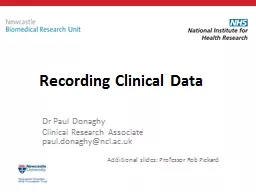

Dr Paul Donaghy Clinical Research Associate pauldonaghynclacuk Additional slides Professor Rob Pickard Plan General points to consider Documentation Storage Sharing Why record clinical data ID: 318257
Download Presentation The PPT/PDF document "Recording Clinical Data" is the property of its rightful owner. Permission is granted to download and print the materials on this web site for personal, non-commercial use only, and to display it on your personal computer provided you do not modify the materials and that you retain all copyright notices contained in the materials. By downloading content from our website, you accept the terms of this agreement.
Slide1
Recording Clinical Data
Dr Paul Donaghy
Clinical Research Associate
paul.donaghy@ncl.ac.uk
Additional slides: Professor Rob PickardSlide2
PlanGeneral points to consider
Documentation
Storage
SharingSlide3
Why record clinical data?Map to research questionHuman
disease phenotype
Demographics
Disease characteristics
OutcomesSlide4
General points to consider
Compliance with Data
P
rotection
A
ct
Necessary approvals (REC, NHS Trusts)
Where NHS patients, data or facilities are
involved:
Compliance with policies and standards of NHS organisation (
inc.
Caldicott
)
Status of data collector with NHS organisation Slide5
Points to consider: study specific
REC submission and study protocol
Patient information sheets and
consent
formsSlide6Slide7
Documentation – What data to record?Collect
enough but no more
From NHS records (can include name, address to contact patient)
Data collected during studySlide8
Documentation
Legible
Accurate and complete
Date, time, signature, name and designation
Corrections made with single line strike-through, initialled and datedSlide9
StorageMedium
Paper, electronic, audio, samples – BACK-UP
Identifiers
Anonymous
(no audit trail)
Pseudoanonymous
(audit trial) – most usual
Patient-identifiable data (to be avoided if possible)Slide10
Storage: University PolicyAdequate, relevant and not excessive
Accurate
Not kept for longer than is necessary
Kept safe from
unauthorised
access, accidental loss or destruction
Secure rooms/lockable cabinets
Password protectedSlide11
Sharing – You need permission!The
patient (consent)
Research Ethics
Committee
Caldicott
GuardianSlide12
Key PointKnow what you are allowed to do
REC application / protocol
Patient information sheets / consent forms
Agreements with NHS bodies
University Policy and legislation:
http
://www.ncl.ac.uk/res/research/ethics_governance/ethics/toolkit/data
/
Slide13
Questions?Slide14
Caldicott Principles1
) Justify the purpose for which the information is needed.
2) Only use personally identifiable information when absolutely necessary.
3) Use the minimum personal identifiable information possible – if possible
use
an identifier number rather than a name.
4) Access to the information should be on a strict need to know basis.
5) Everyone should be aware of his/her responsibilities to respect clients
confidentiality
.
6) Understand and comply with the law. The most relevant legislation is the
Data
protection Act 1998, the Police & Criminal Evidence Act 1984 and the
Human
Rights Act 1998.Slide15
Data Protection Principles1) Information must be processed fairly & lawfully.
2
) Information must be processed for the specific purpose or purposes given.
does not allow for information to be used for more than the purpose it
was originally
collected for, unless specific consent has been obtained or when fair
processing
notices have been issued and agreed.
3
) The information being processed is adequate, relevant and not excessive.
4) That information is accurate.
5
) Information must be kept no longer than is necessary.
requires
that information should only be kept for the designated time scales
whether
determined by legislation or policy retention
periods must
be applied, and
any
destruction of documentation or information should be
done
so in accordance with policy and confidentiality.
6) Information is processed in accordance with the subject’s rights.
means
that the data or information must be collected, used and retained in
accordance
with the rights of the individual and that any relevant exemptions
should be applied.
7) Information is kept secure at all times
all
relevant precautions must be taken to avoid any accidental loss, unlawful
processing
or
unauthorised access
to or damage or destruction of personal data or
information
and this must include applying all security policies
.
8) Information is not transferred to countries or territories outside the
EEA
or to countries or territories without adequate
protection unless Safe
harbour or similar agreements are in place and in operation.
prevents
information being disclosed to countries which do not have adequate
legislation
to
protect personal
information and authorisation should be sough from
the
Caldicott
guardian or Information manager prior to any such releases
.